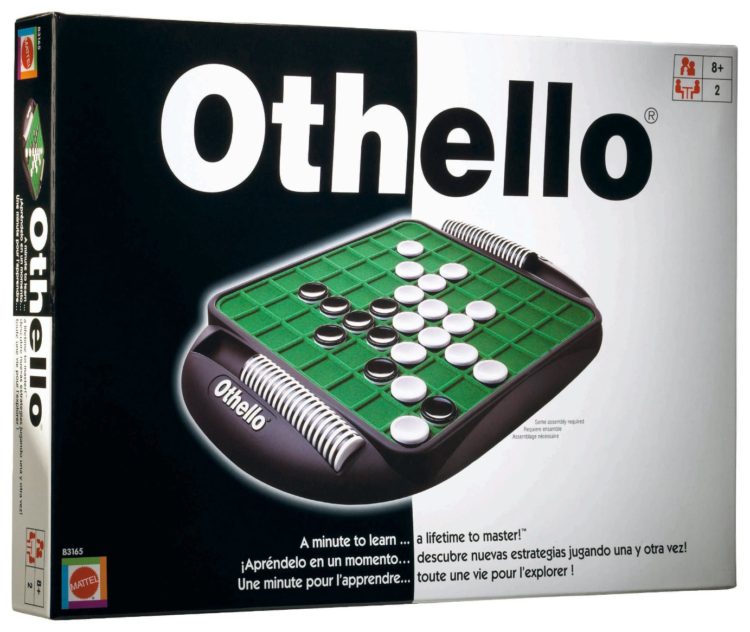Othello, which is also called Reversi, is a strategy game where the objective is to end the game with the most discs of your colour on the board. You gain more discs on the board by “outflanking” or enclosing your opponent’s discs in rows. During this game, you must constantly think about the possible consequences of your moves. Othello is an addicting game with a simple concept, which constantly tests your problem-solving skills.
Game Instructions:
 Each player begins with 32 discs and must select a colour. The game always begins with four discs in the center 2×2 square – two black discs diagonal and two white discs diagonal (see picture). Black always moves first. When you move you must first, “outflank” your opponent and then flip the outflanked disc(s). Outflanking means to place a disc so that your opponent’s row(s) of disc(s) is enclosed on either side by your color of discs. Essentially, you are “sandwiching” your opponent’s chips between your own and then flipping the inside chips to your own colour (please watch the video tutorial for clarification). If you cannot outflank, your turn is forfeited and your opponent continues to move until you can play again. You must move if you can. You can outflank a horizontal, a vertical, and/or a diagonal row at the same time. You may not skip over one of your discs to outflank an opponents disc on the other side. Discs may only be outflanked as a direct result of a move. All discs outflanked must be flipped. If a player makes a mistake they can only change it before their opponent makes a move. Discs cannot be moved once played. If you can make a move but do not have enough discs, your opponent must give you a disc. When neither player can move, the game is over. Whoever ends with the most discs of their colour on the board wins.
Each player begins with 32 discs and must select a colour. The game always begins with four discs in the center 2×2 square – two black discs diagonal and two white discs diagonal (see picture). Black always moves first. When you move you must first, “outflank” your opponent and then flip the outflanked disc(s). Outflanking means to place a disc so that your opponent’s row(s) of disc(s) is enclosed on either side by your color of discs. Essentially, you are “sandwiching” your opponent’s chips between your own and then flipping the inside chips to your own colour (please watch the video tutorial for clarification). If you cannot outflank, your turn is forfeited and your opponent continues to move until you can play again. You must move if you can. You can outflank a horizontal, a vertical, and/or a diagonal row at the same time. You may not skip over one of your discs to outflank an opponents disc on the other side. Discs may only be outflanked as a direct result of a move. All discs outflanked must be flipped. If a player makes a mistake they can only change it before their opponent makes a move. Discs cannot be moved once played. If you can make a move but do not have enough discs, your opponent must give you a disc. When neither player can move, the game is over. Whoever ends with the most discs of their colour on the board wins.

 To create your own Othello Game you can click here for an 8×8 grid and then you can play using 64 integer chips (red/yellow sided circular discs).
To create your own Othello Game you can click here for an 8×8 grid and then you can play using 64 integer chips (red/yellow sided circular discs).
Curriculum Connections
Coming soon.
Connections to Processes
Communication [C]: In Othello students regularly discuss the logic supporting their moves. They also must verbalize the position of their pieces, using language which is the foundation for discussing grids in coordinate geometry. Students also need to explain the lines they are referring to by using mathematical language such as, horizontal, diagonal, and vertical.
Visualization [V]: The game board of Othello provides students with fundamental experience working with grids. It also allows students to see the connection between perimeter and area, as these two elements are important to common strategies used in the game. As students play Othello multiple times they will develop their spatial reasoning and they will move towards being able to visualize the possible moves instead of needing to physically place their piece to view the result. In Othello, it is important for students to be able to see the board as a whole and not just separate sections because everything is connected.
Reasoning [R]: Othello can be played using multiple different strategies, therefore students must be able to defend why they choose their strategy and how it will help them to win. As students play they can test various strategies and draw conclusions, e.g. students may realize the advantage of gaining the perimeter and the corners. Once students test their ideas they will build confidence in their ideas and will be able to justify their logic confidently.
Problem Solving [PS]: The overall goal of students in this game is to maximize their possible positions while minimizing places their opponent can put a disc. As students play they will discover key strategies based on the idea of limiting their opponent’s ability to gain discs, e.g. gaining the corners, the perimeters, and the 2×2 or 4×4 interior squares. However, there are other strategies, e.g. never placing a disc next to an empty corner, which is not always advantageous. Therefore, students must be able to respond to new situations by applying their problem-solving skills.
